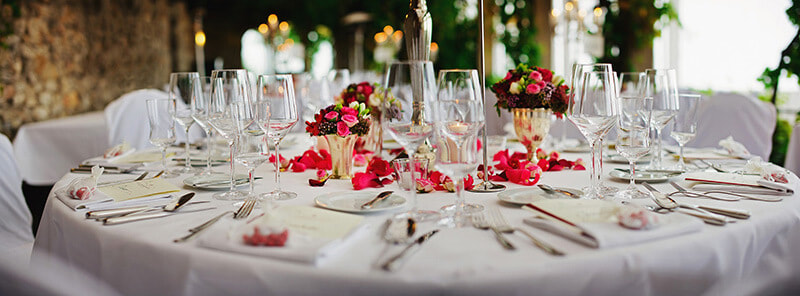|
Dining History Dinner takes on a variety of forms—a quick bite, party buffet, or getting together with family on a relaxing Sunday. There are also formal dinners when linen, China, and sterling silver are gathered and arranged for the best of friends, out-of-town guests, and clients, all of whom will enjoy and be impressed with your magnificent presentation and culinary talents. In her essay, Setting the Table, author Evangeline Holland shares some startling facts about the progression of formal dinners, from the Middle Ages (500 AD, after the fall of the Roman Empire) to the turn of the 20th century. It seems that sharing food in a communal setting was considered a sign of stature and significance. According to Holland’s research, “…the table setting included the Salt Cellar, which was the first thing to put on the table. The salt was far more than a condiment—to sit above the salt was to sit in the place of honor, and until the salt was put upon the table, no one could know which seat would be allotted to him or her.” During the same period, tables would hold massive displays of silver items, holding the poultry, meat, fish, and vegetables; and of course, loaves of bread. What was missing from the tables of these early feasts were utensils, the very items we’re accustomed to finding as a dinner guest. We learn from Holland that; “Spoons and knives…were not furnished by a host, (and forks did not exist), but were brought by guests whose servants, so equipped, cut the meat and carved the food for each person. The guests also had no plates and few knives, but ate with their hands and threw the refuse on the floors. The cleanliness of the cloth, or Nappe, was of paramount importance and a matter of great pride.” Forks and napkins finally came into existence, and have stories of their own; these two items account for the development of proper culinary practices; by all indications, once the pronged instrument was introduced, silversmiths found great inspiration to create other useful items for the most prestigious dining rooms and kitchens of the upper echelon. As for cloth napkins, a full article could be written on their design, material, and folding styles; but, for now, we’ll stay focused on our original intent. As we’ve learned from movies, series, and period documentaries, society moved into an era where royalty and the court used dining events as an opportunity to display their wealth, importance, and control. During the 18th, 19th, and early 20th centuries, with the introduction of proper attire, elevated expectations of social behavior, and refinements in dining protocol, dinner was determined to be a defining moment in the judgment of a person’s status, the class of which the family derived, and its heritage. There are countless stories about those who go to extreme lengths to learn etiquette. These persons know full well that an error or a lack of preparation could tarnish their social standing. There’s also the horror of some poor soul improperly using a glass, knife, or fork, leading to the most sensitive guests in their circle to become faint and to require a breath of fresh air or a drink of water. During the mid to late 19th century, the bourgeoisie (middle-class) was searching for adoration usually reserved for the most connected and affluent; it was through attempts to duplicate the elaborate royal table settings and food choices, did they learn how social climbing through dinner parties would advance their standing. The new norm exercised by a growing population quickly developed. These efforts, accompanied by proper etiquette in social settings, released a new middle-class who found a special opportunity to lift themselves to a new level, which resulted in a body of people segmenting into three sub-classes as we know today. Changes in social advancement resulted in an ever so slight in moderation to the separation of the elite and the newly formed upper-middle class. Still, it was enough to be perceived as an encroachment upon the nobility, and it had to be addressed so that greater distance between the classes could be recognized. This natural evolution invoked the introduction of service à la française, where the serving of all the food-filled dishes are simultaneously delivered to guests onto the table, and then passed. This type of presentation was followed by what is known as service à la russe; each course is presented to the table by servers—in an orderly fashion—allowing food to be enjoyed at the desired temperatures and without interrupting conversations. The change in serving style added greater ambiance to the social occasions, usually turning into a multi-hour dinner, with a long list of courses, into an extravagantly produced event. With the advent of these labor-intensive, orchestrated presentations, households found it necessary to employ greater numbers of staff and servers, who would work around the clock so that guests—in the evening—would be offered the finest and most organized multi-course choices and expensive beverages which would reflect kindly on its host. In-home dining during the later 19th century and into the beginning of the 20th century—in both England and America, were stunning examples of over-the-top tastes and the ability to sometimes overdo a presentation became prevalent; table settings became grandiose, with the combination of food, art—even entertainment being intermingled. Through the use of flowers, mirrors, multilevel serving dishes, weighted candelabras, and enormous sterling silver baskets and centerpieces, it proved difficult to see who sat across the table. The escalation for fine tableware, elaborate displays, and the more costly choices of foods and drinks, was growing out of control. We note that with a quick examination of sterling silver manufacturing history, the role the industry played both overseas and in this country, closely followed the unrealistic demands of an insatiable public, finally causing its demise. (see Gorham Silver: Designing Brilliance, 1850-1970, by Elizabeth A. Williams, David L. Barquist, and Gerald M. Carbone.). With bludgeoning wealth, extolled on the sculpting of reputations through fancy dinner parties, the most privileged found it necessary to add even more staff and extravagant objects—so exaggerated, every detail of the dinner would allow it to appear more successful than the last. Undoubtedly, the house payroll grew, costs escalated, and it was only a matter of time before the formal at-home dinner soirees would eventually collapse during two world wars and the Depression (1929-1939). Details for a new era and generation While much has changed, many people continue to appreciate the delicate and civil interaction that comes with hosting a formal dinner at home. It’s not uncommon to find a proper table setting, inclusive of place cards, specially folded napkins, (sometimes held by an artfully designed or numbered napkin ring), and other highly collectible accessories used centuries ago. There remain historical standards and guidelines to follow, and, whether we like to admit it, people continue to be judged by their knowledge and eating etiquette, whether informal or formal. With this acknowledgment, we offer basic rules of acceptable eating habits and widely-used social skills established over time. We’ve included a diagram of how a properly set table is arranged so that in the event you need a reference, you’ll know where one may be found.
0 Comments
Leave a Reply. |
Click the cover above to receive a free digital subscription
Archives
June 2022
Categories
|
||||||




